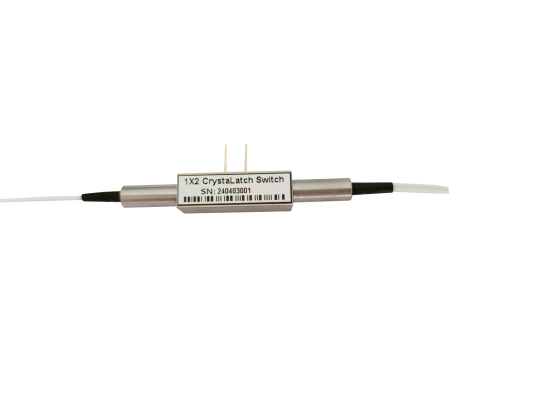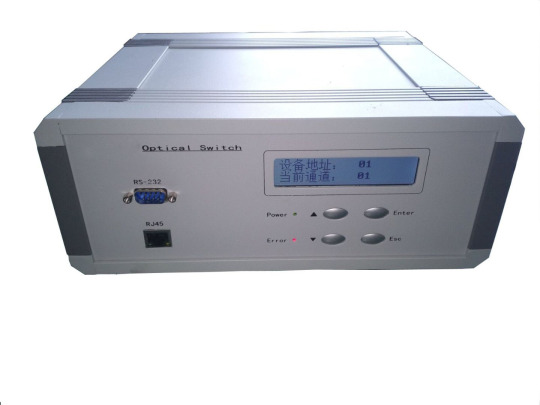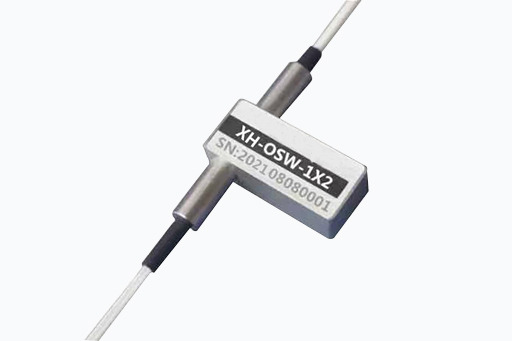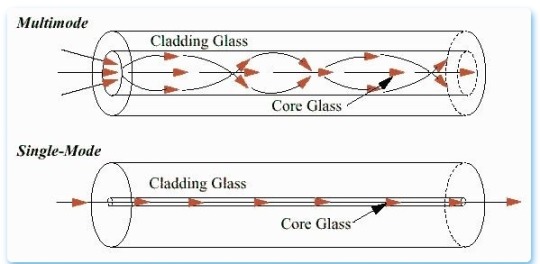Don't wanna be here? Send us removal request.
Text
Working principle and application fields of 24-port fiber optic switch
24-port fiber optic switch is an optical switch with multiple ports (24 ports). It is usually used in applications that require switching between multiple fiber paths. Its working principle and application fields are as follows:
Working principle: Optical signal switching: The main function of a 24-port fiber optic switch is to switch the input optical signal from one port to another through mechanical or MEMS technology to ensure that the optical signal can be transmitted through different channels. Each port can be connected to a different optical fiber device or network path.
Switching method:
●MEMS technology: An optical switch based on microelectromechanical system (MEMS) technology uses tiny mirrors or optical elements to control the transmission path of light. MEMS switches have the characteristics of fast response and low loss, and are suitable for high-speed data transmission.
●Mechanical switch: A mechanical switch driven by a motor or stepper motor can realize the switching of optical signals between multiple ports. It is characterized by strong stability but slow response speed. ●Control method: The working state of the optical switch is usually set by an external control system, such as selecting the port to be connected. Modern optical switches can also be remotely controlled and monitored by software.
Application areas:
● Fiber optic communication system: 24-port fiber optic switches can be used in large-scale fiber optic communication networks for optical path switching, fault protection and traffic management. It is especially suitable for scenarios that require dynamic configuration and flexible adjustment of network connections. ● Data Center: In data centers, fiber optic switches are used for automated network management to support large-scale data transmission and routing. Through optical switches, data centers can achieve rapid switching of optical fibers and improve network efficiency and reliability. ● Optical testing and experiments: 24-port fiber optic switches are widely used in optical testing equipment and laboratories for switching, path selection and signal strength testing of optical signals. It helps to test the performance of different fiber optic components and ensure the efficiency of the testing process. ● Optical network protection: In fiber optic networks, 24-port fiber optic switches can be used to implement optical link protection and automatically switch to backup paths to ensure network reliability and uninterrupted operation. ● Wavelength Division Multiplexing (WDM) System: In WDM systems, by using multi-port optical switches, switching of signals of different wavelengths can be achieved to meet applications with high bandwidth requirements and increase the flexibility and scalability of the network. ●Broadcasting and video transmission: In the broadcasting industry, 24-port fiber optic switches can be used for routing and switching video signals. By switching different signal paths, it can support the switching and broadcasting needs of multiple signal sources.
This fiber optic switch can greatly improve the manageability and fault recovery capabilities of the network, and is suitable for various high-end applications that require multi-channel optical signal routing.
xionghua Photeelectric provides a variety of fiber types: polarization-maintaining, single-mode, multi-mode.
Conventional wavelengths: 532nm, 780nm, 850nm, 980, 1260nm, 1310nm, 1550nm, 1650nm, 2000nm.
Conventional connectors: FP: FC/PC ,FA: FC/APC,SP: SC/PC,SA: SC/APC,LP: LC/PC,LA: LC/APC
Multi-port optical switches: 1X2, 2X2, 1X4, 4X4, 1X8, 8X8, 1X16,16X16, 1X24, 24X24,1X32, 32X32,1X48, 1X64, 1X128…and more channels support customization.
#xhphotoelectric#mems optical switch#optical switch#matrix optical switch#1xn optical switch#youtube
0 notes
Text
Application fields of 8-channel wavelength 532nm mechanical optical switch
Working principle: Mechanical optical switches switch incident light from one path to another by moving internal optical components (such as reflectors or fiber connectors) by electric or manual drive. This switching process is usually completed by a precise control system to ensure the reliability and accuracy of the switch.
Main features: High precision: Due to the use of mechanical drive and high-precision optical components, mechanical optical switches usually have lower insertion loss and better stability.
Low power consumption: Compared with electronic switches, mechanical optical switches do not require additional power to maintain the switching state and only consume a small amount of power when switching.
High stability: Due to its simple structure and based on mechanical principles, mechanical optical switches are usually able to maintain high stability in harsh working environments.
Multi-channel support: Many mechanical optical switches are designed to support multiple optical channels (such as 1xN, NxN, etc.), making them flexible for different optical signal switching needs.
Slow response speed: Due to its mechanical structure, the response time of mechanical optical switches is usually longer than that of electronic switches, so they are mainly used in application scenarios that do not require extremely high speed.
The 8-channel wavelength 532nm mechanical optical switch is mainly used in application fields involving high-precision optical signal management, especially in the fields of optical communication, laser measurement and biological imaging. Its specific applications include:
Optical communication: In optical fiber communication systems, it is used for the selection and switching of multi-channel signals. In particular, it plays an important role in optical network switching, optical path reconstruction, and monitoring of optical fiber communication networks.
LiDAR system: In autonomous driving, drone navigation, ranging and three-dimensional modeling, 532nm wavelength laser signals are widely used for measurement. 8-channel optical switches can help switch different laser paths and improve detection efficiency.
Optical test and measurement: In laboratory testing and precision instruments, mechanical optical switches can switch different light sources or signal channels, especially in spectral analysis that requires multi-wavelength input.
Biomedical imaging: In medical imaging equipment, such as laser confocal microscopy or photoacoustic imaging systems, different optical signal wavelengths (such as 532nm) are used for different types of tissue imaging. Optical switches can dynamically select different optical signal channels for real-time imaging or analysis.
Laser material processing: In industrial applications such as laser cutting and welding, 532nm lasers are often used for high-precision processing. 8-channel optical switches are used to switch between multiple laser sources to increase process flexibility.
Optical sensing system: It can be used for multi-parameter, multi-channel optical sensing systems, allowing different sensor channels to be selected for simultaneous multi-wavelength monitoring.
Nanning Xionghua photoelectric provides: Mechanical optical switches, MEMS optical switches, Magneto-optical switches.
0 notes
Text
What is the lifespan of a mechanical optical switch?
The service life of a mechanical optical switch usually depends on several factors, including the type of switch, the operating environment, the load requirements, the operating frequency, etc. Generally speaking, the service life of a mechanical optical switch can reach 100 million operations or more, especially in low-load and non-extreme environments.
If it is in a high-frequency switching application, or is exposed to environmental conditions such as high temperature, humidity, vibration, etc., the service life may be shortened. In addition, wear of mechanical parts over time will also affect its performance.
To extend the service life of a mechanical optical switch, the following measures can be taken:
Avoid frequent switching operations, especially under high-load conditions. Keep the device dry and clean to avoid dust, moisture, etc. affecting its mechanical parts. When used in extreme environments, consider using a special sealing or protective design.
Xiaohua Photoelectric provides 1X2, 1X4, 1X8, 1X16, 1X24, 1X32 ,1X48, 1X64, 1X128, 2X2,4X4, 8X8, 24X24, MXN and other mechanical optical switch modules. If you need to customize special fiber types and special wavelengths, please contact our sales representative.
#xhphotoelectric#matrix optical switch#1xn optical switch#mechanical optical switch#optical switch#mems optical switch
0 notes
Text
460, 532, 700, 850, 1310, 1550nm MEMS optical switch
MEMS optical switch is a key component in modern optical networks and optical systems. Its performance directly affects the overall performance of the system. With the diversification of application scenarios, MEMS optical switches that can operate in a wide wavelength range of 460nm to 1550nm are becoming more and more important. Different wavelengths correspond to different application requirements: 460nm and 532nm are commonly used in biomedicine and laser display; 700nm and 850nm are mostly used for short-distance data communication; 1310nm and 1550nm are standard wavelengths for optical fiber communication.
Basic principle of MEMS optical switch MEMS optical switch uses movable micromirrors or other optical elements manufactured by micro-electromechanical system technology to change the optical path. Its core working principle is to change the position or angle of the micromirror through electrostatic, electromagnetic or thermal drive to achieve the switching of the optical path. Multi-wavelength operation requires that the following must be considered when designing:
Broadband reflectivity of the mirror coating material
Adaptability of the structural design to the diffraction effects of different wavelengths
Stability of the driving mechanism over a wide spectral range
Wavelength dependence of insertion loss
Technical characteristics of MEMS optical switches at different wavelengths
1. Visible light band (460nm, 532nm)
The main challenges faced by 460nm and 532nm MEMS optical switches include:
Material selection: High reflectivity dielectric mirror coatings are required, usually TiO2/SiO2 or Ta2O5/SiO2 multilayer films
Structural design: Due to the short wavelength, higher requirements are placed on surface roughness and micromirror flatness (<λ/10)
Application areas:
Bioluminescence detection system
Laser projection display
Optical tweezers system
2. Near-infrared band (700nm, 850nm) 700nm and 850nm optical switches are commonly used for:
Short-distance data communication: such as optical interconnection in data centers
Technical features:
Metal mirrors (such as gold, silver) or dielectric mirrors can be used
Relatively loose requirements on surface roughness (about λ/8)
Good compatibility with GaAs-based optoelectronic devices
3. Communication band (1310nm, 1550nm) 1310nm and 1550nm are standard wavelengths for fiber-optic communication, and related optical switch requirements are:
Ultra-low insertion loss: usually <0.5dB
High extinction ratio: >50dB
Fast switching: millisecond to microsecond response
Long-term reliability: >10^9 switching cycles
Design challenges and solutions for multi-wavelength MEMS optical switches 1. Broadband reflector design Achieving broadband high reflection of 460-1550nm requires:
Hybrid coating technology: combining metal film (such as silver) and dielectric multilayer film
Optimizing film system design: using non-periodic multilayer structure or gradient refractive index material
New materials: research and application of two-dimensional materials such as graphene
2. Wavelength-related loss control The loss mechanism of different wavelengths is different and needs to be optimized:
Scattering loss: more significant at the short wavelength end, the surface quality needs to be improved
Diffraction loss: related to the spot size and wavelength ratio, the beam matching needs to be optimized
Absorption loss: material selection is crucial, especially the metal layer
3. Drive mechanism optimization Multi-wavelength system requires the drive mechanism to have:
Stability: maintain performance under different environmental conditions
Consistency: wavelength changes do not cause position deviation
Low power consumption: especially for portable applications
Typical application scenarios 1. Multispectral imaging system Integrated 460-1550nm optical switch can achieve:
Fast wavelength switching: no mechanical filter replacement
Compact design: replace the rotating mirror in traditional spectrometers
Dynamic range extension: cover visible to near infrared at the same time
2. Intelligent fiber network In PON and SDN, MEMS optical switch supports:
Dynamic wavelength allocation: allocate 1310nm and 1550nm resources on demand
Fault protection: fast switching of backup optical paths
Network reconstruction: flexible adjustment of topology
3. Biomedical detection Multi-wavelength optical switch realizes:
Multi-parameter detection: such as blood oxygen (660nm, 940nm), fluorescence (460nm, 532nm)
Micro endoscope: multi-modal imaging integration
Optical coherence tomography: fast wavelength scanning
#xhphotoelectric#mems optical switch#matrix optical switch#mechanical optical switch#optical communication#optical switch#1xn optical switch
0 notes
Text
Polarization-Maintaining Fiber Coupler: Working Principle, Structure and Characteristics

Polarization-Maintaining Fiber Coupler (PM fiber coupler) is a special fiber device that can keep the polarization state unchanged during the transmission of optical signals. This device has important application value in modern optical fiber communication systems, optical fiber sensing, interferometry and quantum optics. This article will introduce the working principle, structural characteristics and performance characteristics of polarization-maintaining fiber coupler in detail. Read more https://www.xhphotoelectric.com/polarization-maintaining.../
#xhphotoelectric#mems optical switch#photonics#matrix optical switch#optical communication#optical switch
0 notes
Text
#xhphotoelectric #opticalswitch #Data #fiber #optics #photonics #NetworkSwitch #FiberOpticCirculator
1 note
·
View note
Video
youtube
#1xN 랙 마운트 광 스위치 #광스위치 #데이터 #광섬유 #광학 #포토닉스 #네트워크스위치 #opticalnetworks #...
0 notes
Video
youtube
#optics #xhphotoelectric #fiberoptics #MEMSopticalswitch #data #photon...
0 notes
Video
youtube
#olp Optical Line Protection System #xhphotoelectric #system # #optics ...
0 notes
Text
Why are variable optical attenuators so important?
Variable optical attenuators (VOA) play a key role in dynamic control of signal levels and offer several advantages over fixed attenuators. Here are the reasons why VOA is an essential component of modern optical networks: real-time signal conditioning; flexibility and versatility; dynamic range; network optimization; troubleshooting and testing.
Fiber optic attenuators play a vital role in enhancing optical communication systems, enabling precise control of signal levels, minimizing signal distortion and optimizing network performance. From long-haul transmission networks to FTTH deployments and DWDM systems, attenuators provide flexibility, reliability and cost-effectiveness in meeting the complex challenges of modern telecommunications. As the demand for high-speed, high-bandwidth connections continues to grow, fiber optic attenuators will remain an integral component in building robust and efficient optical communications infrastructure.
#xhphotoelectric#VOA#FTTH#WDM#OpticalNetwork
Read more https://www.xhphotoelectric.com/

#xhphotoelectric#mems optical switch#photonics#optics#fiberoptic#mxn optical switch#matrix optical switch#optical switch#voa
0 notes
Video
youtube
#1XN optical switch module #opticalswitch #optics #xhphotoelectric # #op...
#youtube#Contact us Web:www.xhphotoelectric.com WeChat/Whatsapp:+8618154626356 Email:[email protected]
0 notes
Text
Characteristics of magneto optical switches
The structure of a magneto-optical switch usually includes components such as a polarization rotator (such as quartz polarization rotator and Faraday polarization rotator), birefringent crystal (such as yttrium vanadate crystal), polarizing beam splitter and total reflection prism. Among them, the function of the polarization rotator is to fix or change the polarization direction of light, while the birefringent crystal is used to separate or combine light beams with different polarization directions.
The advantages of magneto-optical switches are: no moving parts, low power consumption, stable and reliable, relatively fast switching speed (tens of microseconds), and relatively simple process. The disadvantage is that it is inconvenient to integrate.
Magneto-optical switch has the following characteristics:
1. No moving parts: The working principle of the magneto-optical switch is based on the interaction of magnetic field and light and does not require mechanical moving parts, so it has high stability and reliability.
2. Low power consumption: Since no moving parts are required, the power consumption of magneto-optical switches is relatively low.
3. Stable and reliable: Since there is no mechanical movement, the magneto-optical switch has a long life and is not easily affected by external environmental factors such as vibration and impact.
4. Fast switching speed: The switching speed of the magneto-optical switch can reach tens of microseconds, which is suitable for occasions that require fast response.
5. Simple process: The manufacturing process of magneto-optical switches is relatively simple, which reduces production costs.
#xhphotoelectric#opticalswitch#fiber#optical#photonics#NetworkSwitch
Read more : https://www.xhphotoelectric.com/.../1x2-magneto-optical.../

#xhphotoelectric#mems optical switch#matrix optical switch#photonics#mechanical optical switch#mxn optical switch#1xn optical switch
0 notes
Video
youtube
1X2 magneto optical switch #communication #opticalswitch #optics#xhphot...
#youtube#Nanning Xionghua Photoelectric Technology Co. Ltd. produces: optical switch MEMS optical switch OLP VOA optical attenuators WDM optical fibe
0 notes
Text
Desktop optical switch
Desktop optical switch is a kind of light path control equipment, which mainly plays the role of controlling the light path and switching the light path. It can manually select and switch the working light path through the panel buttons, can also control the light path switching through the RS232 serial port, Ethernet port, or set the frequency to automatically scan the light path that needs to be monitored and switched. Desktop optical switches are widely used in optical communication projects, including but not limited to multi-channel optical monitoring in optical transmission systems, LAN multi-light source/detector automatic switching, and light sensing multi-point dynamic monitoring systems. In addition, it is also used in optical testing systems for testing optical fibers, optical devices, networks and field engineering optical cables,as well as installation and adjustment of optical devices.
#xhphotoelectric #opticalswitch #optical #optics #photonics #fiber #communications #telecommunications #NetworkSwitch Read more : https://www.xhphotoelectric.com/en/1x18-rack-optical-switch/

Web:www.xhphotoelectric.com
WeChat/Whatsapp:+8618154626356
Email:[email protected]
#xhphotoelectric#mems optical switch#matrix optical switch#optical switch#mxn optical switch#photonics#mechanical optical switch#fiberoptic#optics#1xn optical switch
0 notes
Text
1X2 Mechanical optical switch
XH-OSW-1X2 mechanical optical switch is an optical path control device with the function of controlling the optical path and converting the optical path; it can realize 2 optical signal inputs and select the signal output of one of them (supporting bidirectional use). It has an important role in optical communication applications. Optical switch is mainly used for multiple optical monitoring of optical transmission system, automatic switching of multiple sources/detectors in LAN, and multi-point dynamic monitoring system of optical sensing Optical test system is used for optical fiber, optical devices, network and field engineering for optical cable testing; installation and commissioning of optical devices.
#xhphotoelectric #opticalswitch #optics #photonics #fiber #communications #telecommunications #통신 #télécommunications #Telekommunikation #연락 #광스위치 #광학 #포토닉스
Read more : https://www.xhphotoelectric.com/1x2-fiber-optical-switch/

#xhphotoelectric#mems optical switch#matrix optical switch#optical switch#mxn optical switch#mechanical optical switch#1xn optical switch#fiberoptic#photonics
0 notes
Text
Transmission distance of single-mode fiber and multi-mode fiber
Single-mode fiber (SMF): Due to its small core diameter and lower attenuation, single-mode fiber is suitable for longer transmission distances. Single-mode optical fiber can achieve signal transmission of tens of kilometers or even hundreds of kilometers, and is especially suitable for long-distance communications and cross-continental and cross-sea optical fiber cables. Multimode fiber (MMF): Multimode fiber is suitable for shorter transmission distances, generally in the range of several kilometers. Due to dispersion problems and attenuation, the transmission distance of multimode fiber is relatively limited and is more suitable for local area networks, short-distance communications and some low-bandwidth applications.
Read more : https://www.xhphotoelectric.com/en/category/products/collimator-products/dual-fiber-pm-high-power-collimator/
#xhphotoelectric #optics #fiber #opticalswitch #FTTH #LAN #communication #telecommunications #FiberOpticSensing

#xhphotoelectric#mems optical switch#matrix optical switch#optical switch#photonics#mxn optical switch#mechanical optical switch#optics#1xn optical switch#fiberoptic
0 notes